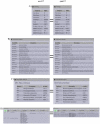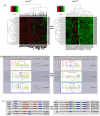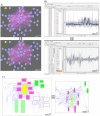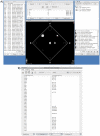Comparative microbial modules resource: generation and visualization of multi-species biclusters
- PMID: 22144874
- PMCID: PMC3228777
- DOI: 10.1371/journal.pcbi.1002228
Comparative microbial modules resource: generation and visualization of multi-species biclusters
Abstract
The increasing abundance of large-scale, high-throughput datasets for many closely related organisms provides opportunities for comparative analysis via the simultaneous biclustering of datasets from multiple species. These analyses require a reformulation of how to organize multi-species datasets and visualize comparative genomics data analyses results. Recently, we developed a method, multi-species cMonkey, which integrates heterogeneous high-throughput datatypes from multiple species to identify conserved regulatory modules. Here we present an integrated data visualization system, built upon the Gaggle, enabling exploration of our method's results (available at http://meatwad.bio.nyu.edu/cmmr.html). The system can also be used to explore other comparative genomics datasets and outputs from other data analysis procedures - results from other multiple-species clustering programs or from independent clustering of different single-species datasets. We provide an example use of our system for two bacteria, Escherichia coli and Salmonella Typhimurium. We illustrate the use of our system by exploring conserved biclusters involved in nitrogen metabolism, uncovering a putative function for yjjI, a currently uncharacterized gene that we predict to be involved in nitrogen assimilation.
© 2011 Kacmarczyk et al.
Conflict of interest statement
The authors have declared that no competing interests exist.
Figures






Similar articles
-
Integrated biclustering of heterogeneous genome-wide datasets for the inference of global regulatory networks.BMC Bioinformatics. 2006 Jun 2;7:280. doi: 10.1186/1471-2105-7-280. BMC Bioinformatics. 2006. PMID: 16749936 Free PMC article.
-
The Gaggle: an open-source software system for integrating bioinformatics software and data sources.BMC Bioinformatics. 2006 Mar 28;7:176. doi: 10.1186/1471-2105-7-176. BMC Bioinformatics. 2006. PMID: 16569235 Free PMC article.
-
Multi-species integrative biclustering.Genome Biol. 2010;11(9):R96. doi: 10.1186/gb-2010-11-9-r96. Epub 2010 Sep 29. Genome Biol. 2010. PMID: 20920250 Free PMC article.
-
coliBASE: an online database for Escherichia coli, Shigella and Salmonella comparative genomics.Nucleic Acids Res. 2004 Jan 1;32(Database issue):D296-9. doi: 10.1093/nar/gkh031. Nucleic Acids Res. 2004. PMID: 14681417 Free PMC article.
-
Multi-omic and multi-view clustering algorithms: review and cancer benchmark.Nucleic Acids Res. 2018 Nov 16;46(20):10546-10562. doi: 10.1093/nar/gky889. Nucleic Acids Res. 2018. PMID: 30295871 Free PMC article. Review.
Cited by
-
Reuse of public genome-wide gene expression data.Nat Rev Genet. 2013 Feb;14(2):89-99. doi: 10.1038/nrg3394. Epub 2012 Dec 27. Nat Rev Genet. 2013. PMID: 23269463 Review.
-
Integrated inference and analysis of regulatory networks from multi-level measurements.Methods Cell Biol. 2012;110:19-56. doi: 10.1016/B978-0-12-388403-9.00002-3. Methods Cell Biol. 2012. PMID: 22482944 Free PMC article. Review.
-
Comparative Analyses of Gene Co-expression Networks: Implementations and Applications in the Study of Evolution.Front Genet. 2021 Aug 13;12:695399. doi: 10.3389/fgene.2021.695399. eCollection 2021. Front Genet. 2021. PMID: 34484293 Free PMC article. Review.
References
-
- Stuart JM, Segal E, Koller D, Kim SK. A gene-coexpression network for global discovery of conserved genetic modules. Science. 2003;302:249–255. - PubMed
Publication types
MeSH terms
Substances
Grants and funding
LinkOut - more resources
Full Text Sources
Molecular Biology Databases

